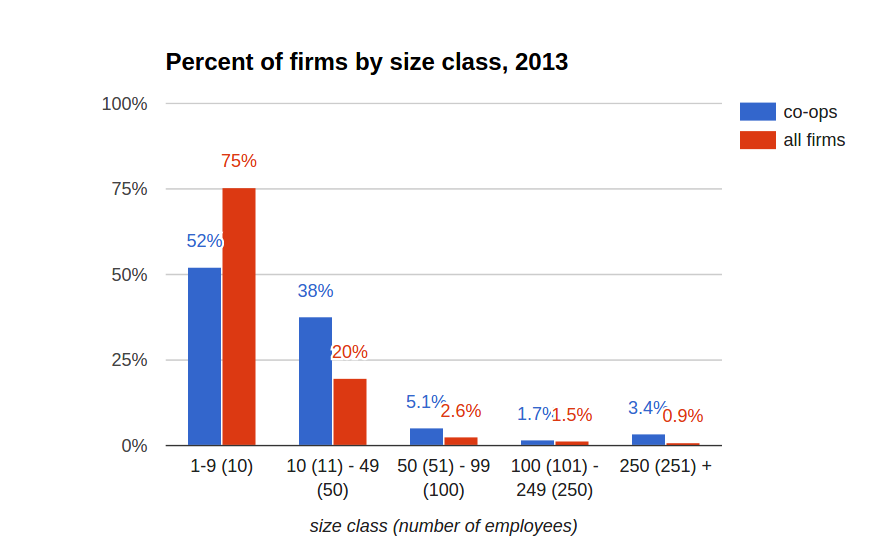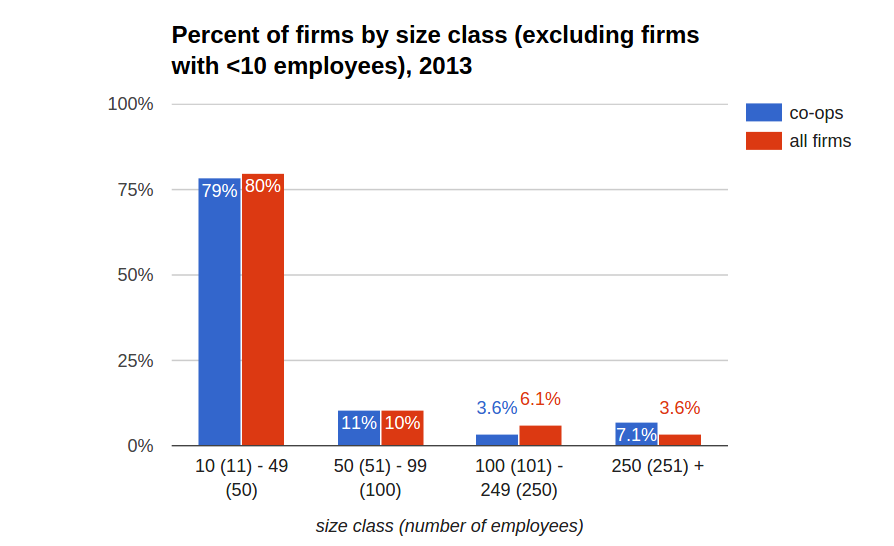In “What Do We Really Know About Worker Co-operatives?“, Virginie Pérotin writes,
“Perhaps the most common received idea about worker co-operatives is that they must be small. It is often thought worker co-operatives must be financially constrained, and a small size is sometimes regarded as a condition for workplace democracy to function… People will also commonly remark that very large worker co-operatives are extremely rare…. What is not widely understood is that most firms actually are very small.” (p.6)
Pérotin cites research studies from Italy, the US, Spain, France, and Uruguay, which all indicate that, on the whole, worker-owned cooperatives tend to be slightly larger than conventional firms (p. 6-9).
In the US, the best estimate of the size distribution of cooperatives comes from the Democracy at Work Institute (DAWI) . Their 2013 survey of US worker-owned cooperatives shows a size distribution consistent with Pérotin’s research: on the whole, US worker co-ops seem to be somewhat larger than other firms:

Now, by definition, a worker cooperative has three or more employees. Any fewer, and the business would be considered a partnership or sole proprietorship. Since the US economy, like most economies, is dominated by small firms, especially sole proprietors with no employees, perhaps we should exclude the smallest firms from our analysis, to see what happens when we take away both the smallest co-ops and the smallest conventional firms:

Excluding firms with 10 or fewer employees, the distribution of businesses by size looks very similar, whether the business is a worker co-op or conventional firm. DAWI’s sample size of 117 firms is quite small, of course, although it is an impressively large sample, considering that there were only 256 worker co-ops in the US at the time of this survey, according to their analysis.
While this quick analysis doesn’t constitute the same type of rigorous academic research cited by Pérotin, it also doesn’t contradict the finding that, in the US and worldwide, worker cooperatives are by no means smaller firms than conventional businesses – if anything the data suggest they may consistently be larger.
References:
Pérotin, Virginie “What Do We Really Know About Worker Co-operatives?”
http://www.uk.coop/sites/default/files/uploads/attachments/worker_co-op_report.pdf
Democracy at Work Institute, “US Worker Cooperatives: A State of the Sector”
http://institute.coop/sites/default/files/resources/State_of_the_sector_0.pdf
US Bureau of Labor Statistics, National Business Employment Dynamics Data by Firm Size Class, Table G. Distribution of private sector firms by size class
http://www.bls.gov/web/cewbd/table_g.txt

